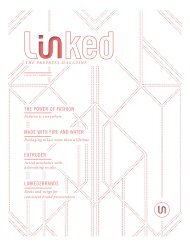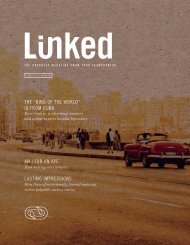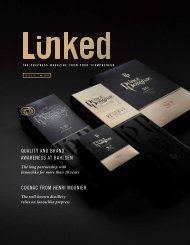Janoschka magazine_Linked_V2_2017
Create successful ePaper yourself
Turn your PDF publications into a flip-book with our unique Google optimized e-Paper software.
issue #2 © l i n k e d<br />
41<br />
The pages have four lines per row and a learning<br />
house at the beginning and end of each row.<br />
This helps first graders, in Germany, to assimilate<br />
the ascenders, mid lengths and descenders of letters.<br />
swg-online.de/lineaturen<br />
france<br />
The most popular and widely used format for lines in<br />
France is the “grands carreaux” (large squares) or “réglure<br />
Seyès”. It originated from the paper trader, Jean-Alexandre<br />
Seyès, who developed this system of lines in 1892,<br />
and even had its design registered at a court in Pontoise.<br />
With its large number of horizontal and vertical reference<br />
points, the “réglure Seyès” simplified the teachers’ work<br />
enormously. That is to say that they could now give clear<br />
guidance as to the lengths of the ascenders and descenders,<br />
the size of the letters as well as the right positioning<br />
of the accents, without moving from their own desk. With<br />
the introduction of compulsory schooling in 1882, the<br />
classes had increased up to 50 pupils. It was, therefore, no<br />
longer possible for teachers to check individually how their<br />
pupils were learning to write nor to make adjustments by<br />
guiding their pupils’ hands.<br />
This distinctive arrangement of lines is still used in France<br />
and in North Africa by all grades today. It is only supplemented<br />
by small squares for mathematical subjects. In the<br />
1980s the “grands carreaux” made advances in Germany,<br />
becoming a trendy product with students and yuppies.<br />
germany<br />
Unlike France, German pupils have a total of 34 sets of<br />
lines available to them – not counting the ones for the first<br />
writing and maths exercises. The reason may be that primary<br />
school pupils in Germany learn the 26 letters of the<br />
Roman alphabet in four different writing styles. In the East<br />
German states, the style of writing that is still often taught<br />
is the one that was introduced by the GDR in 1968. In the<br />
West however, many primary schools start with block lettering,<br />
progressing then to cursive script in the second and<br />
third grade. Depending on the teacher’s personal preference,<br />
this is either the Lateinische Ausgangsschrift (LA)<br />
style of writing or the simplified version, Vereinfachte Ausgangsschrift<br />
(VA).<br />
There are exercise books available in all sorts of variations<br />
to make learning and practising easier: there is the extralarge<br />
or seven-line system, exercise books with a colourcontrasted<br />
background, a pronounced middle field or<br />
dotted lines in the middle, ones for left-handed and righthanded<br />
people, punched on both sides, with a margin on<br />
the left or the right or on both sides. The shopping lists at<br />
the beginning of a school year are elaborate and tricky –<br />
regardless of the colour and quality of the cover, which can<br />
also be specified by the teacher.









